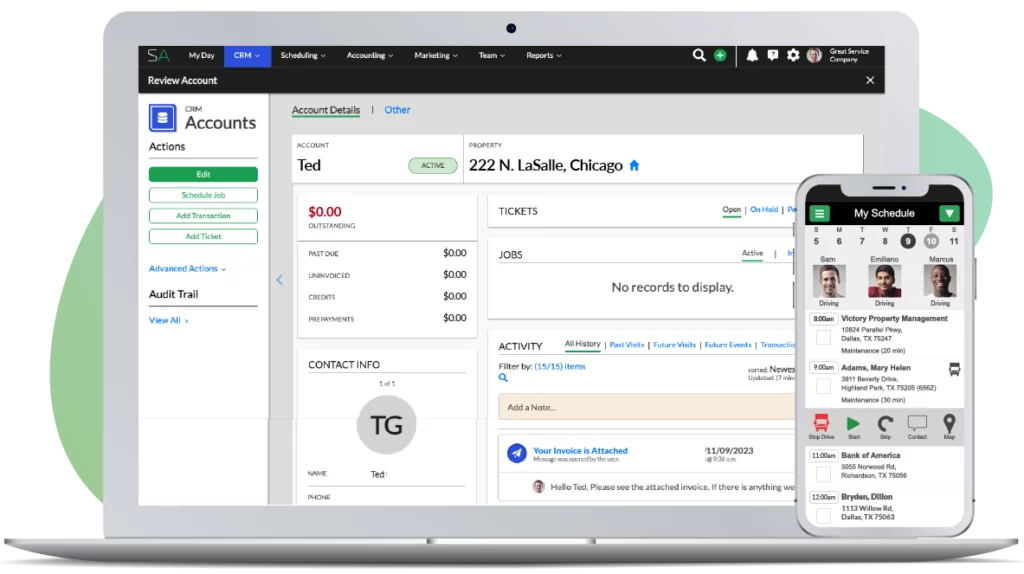So, you are out of the field and ready for the next phase of your company. Watch the video and learn the best practices to make your lawn care business grow.
Hey. I’ve got a question, and I’m going to read the question to you and then I’m going to give you my answer. The question is, “My business is off to a smooth start. I’m out of the field. I track all of my marketing and every other piece of data possible. My cash flow is healthy and I’m running good margins. What are some things that I can do to work on my business?”
This is a really good question. It’s a little difficult to answer because I don’t know the exact situation you’re in. I don’t know the current size of your business. I don’t know how big your team is, so I’m going to throw some things out. I hope it’s of value. I made a little checklist here that I’m going to run through with you real quick.
For sure, now that you’re out of the field and you’re moving more into a true President, CEO type role, meaning you’re running the company and that’s your focus, one of your biggest objectives as the owner, as that CEO is to build the team. What you want to be thinking about, and it’s a little difficult when you’re not – let me first say what you want to think about is if you’re at 0.5 million now, you want to take your company to 1.5 million. Maybe that’s the next goal. To get to 1.5 million, you’re going to need a set of people on your team, of differing levels of experience, probably not all just young, inexperienced individuals that are going to help you, fit you, that are going to grow with you that you’re going to mentor, but some that have actually accomplished some things and have been through some challenges with other companies that you can bring their experience into your company.
One of your challenges is that it’s hard to know exactly what you’re going to bump into, having not yet been there, but to go from, in my example, 0.5 million to 1.5 million, you’re going to start to need more people in the team that can take things off of your shoulders and just run with them and do them. What’s going to happen is you’ll have certain services within your business or certain profit centers that continue to challenge you, meaning that the problems all fall back on you, or improving that area of the business is all on your shoulders and you need to bring in some expertise to take that over.
A great example is for a lot of maintenance companies that do a lot of different services, fertilization weed control is one that requires some level of knowledge, a level of skill. There’s just a lot that goes into fertilization weed control and I feel that oftentimes, that service tends to stay on the owner’s shoulder longer than some other services such as mowing or bush trimming. A lot of times you can find someone, an operational person to take some of that lawn care maintenance type stuff, whereas that fertilization weed control, which is more technical, there’s more things to diagnose, and that tends to fall back on the more skilled individual in the company, which oftentimes is the owner in the early days.
That’s an area where how can you bring some expertise in, and then how can you bring some expertise in to take over some of your marketing. How can you bring better and better salespeople onto the team? That’s what you want to be thinking about now. Your role is shifting into one of building the team, recruiting the right people and putting them in the right place. What’s going to happen as you continue to scale the company from 0.5 million in my example, to 1.5 million to 3 million, you’re going to have people on your team that can help you build the company and work within the company. You’re also going to build some systems and processes. They may be very formal or they might be informal, but what’s going to happen as the business grows, you have more clients, more phone calls, more to dos, more jobs and a bigger team. Things are going to start to break.
You’ll just start to see problems, where in the past something worked really well, and now that thing doesn’t work so well anymore, for whatever reason. Maybe different people are within the company, there’s some confusion about who’s actually in charge of that thing. There’s lots of scenarios of how that thing, whatever that system is, might no longer work as well as it used to and you have to go work on that process and rethink and rebuild it. As you grow the business, you’ll understand what I’m talking about if you haven’t experienced that just yet, but you don’t put systems in place at 0.5 million that continue to be the systems that run the company at 3 million.
As that company continues to double and triple and maybe triple’s a good example, as it continues to triple in employee count and revenue, things start to fall apart and they have to be rebuilt. That’s why you don’t get all your ducks in a row at 0.5 million and everything’s smooth sailing to 10. No, things continue to crop up that produce problems and challenges and the reason most companies never get past to 0.5 million in revenue and then they get hit at another plateau somewhere in the couple million dollar range, and definitely there’s a plateau at 5 million is because they didn’t go back – use creativity and problem solving to fix all the stuff that used to work that no longer works.
Another one is you really want to now pay attention to what are you doing, where are you spending your time? Are you spending your time on low value activities that are important to the business but could be performed by somebody else? One thing that will put you in a situation where you hit that plateau, whatever that revenue number is for you and your business, one of the reasons that most owners hit a plateau is because they’ve got a lot of things that need to happen to keep the company running, they have to happen, but they don’t have to be performed by you the owner, you’re not outsourcing that stuff. It all stays on your shoulders, you’re too busy to work on the next thing or fix the next thing that broke and as a result, your company stalls.
Now what you want to do is you want to look for the things within your business that are low dollar activities, that in other words, that doesn’t diminish the activity, it just simply means that you could find somebody less expensive than you to perform that activity. That then frees you up to focus on the next level of activities. Then eventually, same thing will happen again. You’ve progressed and grown as an owner, your ability has grown. You are now doing things that you should get off your plate and now move to the next level, and that’s just how it continues to function until you reach a point where you really literally perform no activity within your business. You’re the coach, mentor, team builder, culture builder but you’re not the guy doing anything, any of the actual work. All of that work is performed by someone else. It doesn’t mean you’re not doing work. You’re just doing a new kind of work which is almost completely thought work, completely creativity type work.
Two more, you’re tracking data, you’re tracking metrics. Now, what can you do with those metrics? What can you do with that data now that you’re tracking it? For example, really focus hard on conversion. For example, if you’re converting 45% of leads to clients, how can you get that to 50%? How can you get that to 55%? That requires relentless focus. To bump conversion, there’s a lot of things that go into conversion. It’s not just the conversation happens on the phone or the email that’s sent back to the client. Within conversion, you can break it down into sell steps, touch points and each one of those little touch points or sell steps could bump conversion by 1% or 2% or 3%, and so you need to break down that sales process into steps and you need to focus on each of those little steps and in doing so, you’ll gain some points, improve your conversion in a number of areas. That together will add up to be 5%, 10%, 20%, 30%. You want to focus on that every month.
Another big one to focus on is your revenue per client. You want to watch how much revenue do you make on average per client. Right now, if an average client to your company’s worth $2,000 a year, what could you do through marketing and sales, and maybe building in additional profit centers within your business, additional product lines and you want to be careful with doing too much of that, how can you make that client worth $2,500 a year, and then $3,000 a year? How can you drive the transactional volume or value of every client up?
In other words, if you could take, this is way easier said than done but if you could take your average client value at $2,000 and make it $3,000, you’ve just grown your business by 50% without adding a single client. Again easier said than done but that’s something to really be working on.
Then finally, I’ll leave it with really focusing on job costing in non-billable time, so that means that every single property is being analyzed. You’re tracking the data. Now are you looking at it daily? Are you talking to your crews about it? Are you internally thinking through why one job isn’t as profitable as another? Are you looking at all your jobs and making sure that at a profit level, you’re getting them all up to a certain benchmark and you’re either getting rid of the stragglers or you’re fixing them or you’re identifying what the problem is. Maybe you’re running your trucks too far out of your market and you need to tighten up that geography because the properties that are so far out, you’re just not making any money on them and you can’t build that territory, that area fast enough with sales and marketing to make it profitable. So, maybe you need to again tighten up and focus on a specific area.
That’s just an example, but focusing on the job costing every single day and watching the numbers and fixing the stragglers, fixing the ones that aren’t achieving your target per man hour rate on that property and fixing it will have a dramatic impact on your profits. If you can’t make a job profitable when the crew or the tech is on the property, then you can’t fix that job because you’ve got job drive time and non-billable and all these other factors that layer on top of that job so if you can’t, just starting with the basics, you’ve got to make that job really profitable on a per man hour basis when they set foot on the job, and while they’re on the property.
If you can’t fix that, that’s the first thing you fix. Once you fix all of that, then you start focusing on things like non-billable time. How can you drive down the time at the gas station? How can you drive down the time in the morning to get ice and water? How can you drive down maintenance time? How can you drive down all of those activities that happen within the business, getting out the gates in the morning, going over the route sheet or reviewing the notes on the mobile. I can go on and on. There’s tons of non-billable things that happen within a business in the morning that affect payroll, the biggest expense in your business. How can you focus on driving that stuff down, because every dollar you take out of non-billable time, basically money you’re spending that you can’t get a return on, every dollar you save in that area goes straight to your profit, goes straight to your bottom line.
Those are some things I’d work on that will all be difference makers and the list of what else you need to do is that long but you start with four or five. You focus on them and you figure out the next four or five and you just keep doing that pretty much for the rest of your life. Now one day, you build a team around you that’s doing that for you as well and it’s not all on you and then it becomes far, far easier. Start there.



